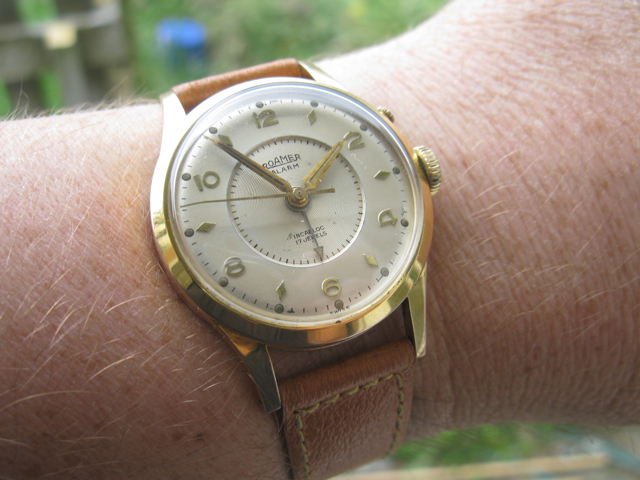Roamer's first alarm calibre - the watch here is in fine condition, with little wear to the case and a fine patina to the dial. This is an early style watch, with the first model MST 417, placing it in the early 1950s. The MST 417 was replaced in 1955 with the MST427, with a significantly revised alarm cancel and hammer mechanism. A Roamer Alarm with either calibre is one of the hardest Roamer watches to find, although no production figures remain - it was not a high number. I think it is best said in the words of a former Roamer manager - "we didn't make many of those". The calibre numbers are not visibly marked - except under the dial. The way you can tell the difference at a glance is the extra hole by the Roamer text by the hammer in the 417.
This is an in-house movement of considerable sophistication, with only 1 crown to set, time and alarm and wind the separate alarm and main barrel. This calls for a 3 position crown and horribly complex setting mechanism. Wonderful - especially compared to the pedestrian AS1475 that was fitted to most contemporaries, this Roamer calibre was on the market several years before the AS calibre - which used 2 crowns, and shortly after Vulcain's famous calibre 120 Cricket.
Another interesting item, is the back which tuned with grooves - to give a clear bell like ring. This was difficult for most alarm watches of the period as Vulcain had wrapped up the twin shelled sounding back in patents, and most alarm watches (Benrus, Bulova, Technos, etc etc) had to put up with a dull thudding noise instead of a clear bell. This was Roamer's way around Vulcain's patents. Clever!
The single pusher is to cancel the alarm. When winding, the alarm is wound when the crown is rotated clockwise, and the mainspring is wound when rotating anti-clockwise. The alarm sets when the alarm spring is wound. The second position on the stem adjusts the alarm pointer, and the third position sets the hands. The winding mechanism features a rocker as in the Vulcain cricket that winds the barrels, depending on the direction of the winder.
Associated Patents
1951 hammer mechanism CH295436 - MST 417 1952 sounding back CH304446 1955 revised hammer mechanism CH321585 - MST 427
|






